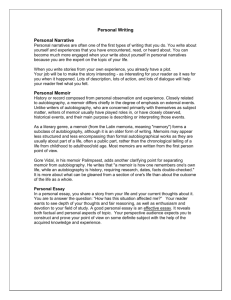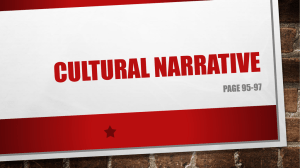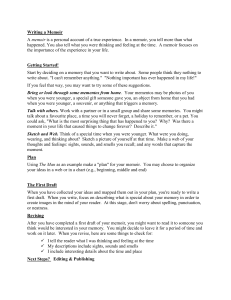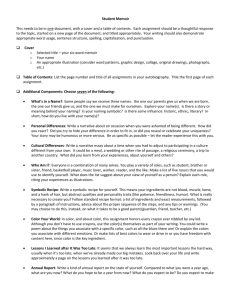Memoir Prompt and Rubric
advertisement
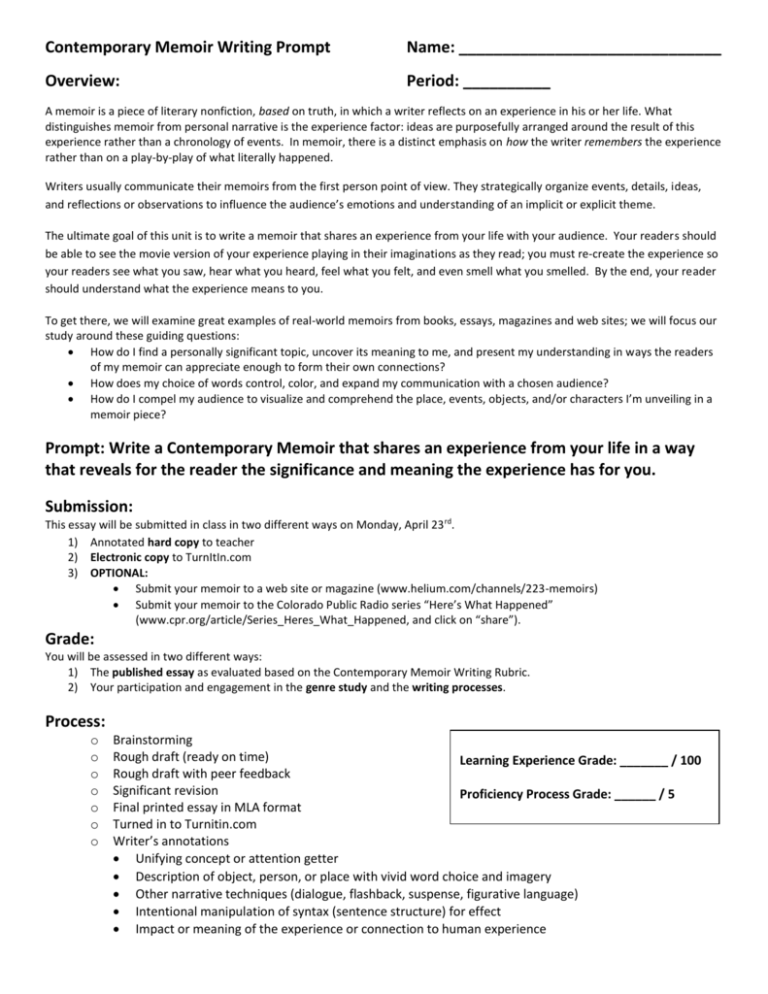
Contemporary Memoir Writing Prompt Name: ______________________________ Overview: Period: __________ A memoir is a piece of literary nonfiction, based on truth, in which a writer reflects on an experience in his or her life. What distinguishes memoir from personal narrative is the experience factor: ideas are purposefully arranged around the result of this experience rather than a chronology of events. In memoir, there is a distinct emphasis on how the writer remembers the experience rather than on a play-by-play of what literally happened. Writers usually communicate their memoirs from the first person point of view. They strategically organize events, details, ideas, and reflections or observations to influence the audience’s emotions and understanding of an implicit or explicit theme. The ultimate goal of this unit is to write a memoir that shares an experience from your life with your audience. Your readers should be able to see the movie version of your experience playing in their imaginations as they read; you must re-create the experience so your readers see what you saw, hear what you heard, feel what you felt, and even smell what you smelled. By the end, your reader should understand what the experience means to you. To get there, we will examine great examples of real-world memoirs from books, essays, magazines and web sites; we will focus our study around these guiding questions: How do I find a personally significant topic, uncover its meaning to me, and present my understanding in ways the readers of my memoir can appreciate enough to form their own connections? How does my choice of words control, color, and expand my communication with a chosen audience? How do I compel my audience to visualize and comprehend the place, events, objects, and/or characters I’m unveiling in a memoir piece? Prompt: Write a Contemporary Memoir that shares an experience from your life in a way that reveals for the reader the significance and meaning the experience has for you. Submission: This essay will be submitted in class in two different ways on Monday, April 23 rd. 1) Annotated hard copy to teacher 2) Electronic copy to TurnItIn.com 3) OPTIONAL: Submit your memoir to a web site or magazine (www.helium.com/channels/223-memoirs) Submit your memoir to the Colorado Public Radio series “Here’s What Happened” (www.cpr.org/article/Series_Heres_What_Happened, and click on “share”). Grade: You will be assessed in two different ways: 1) The published essay as evaluated based on the Contemporary Memoir Writing Rubric. 2) Your participation and engagement in the genre study and the writing processes. Process: o o o o o o o Brainstorming Rough draft (ready on time) Learning Experience Grade: _______ / 100 Rough draft with peer feedback Significant revision Proficiency Process Grade: ______ / 5 Final printed essay in MLA format Turned in to Turnitin.com Writer’s annotations Unifying concept or attention getter Description of object, person, or place with vivid word choice and imagery Other narrative techniques (dialogue, flashback, suspense, figurative language) Intentional manipulation of syntax (sentence structure) for effect Impact or meaning of the experience or connection to human experience Writing Rubric Contemporary Memoir Orientation/ Opening Ideas and Organization Score: _________ Development of Ideas Development of Internal Structure Closure Craft and Style Score: ______ Proficient (Meets) 4 Partially Proficient (Approaching) 3 Unsatisfactory (Does Not Meet) 2 Opening advances a unifying concept or metaphor that guides and sets the direction for the memoir as a whole. Employs flashback and foreshadowing to identify, introduce, and develop a personal voice and the character of the narrator. True meaning of the title is revealed as the piece unfolds. Narrative techniques (e.g. description, details, characters and/or dialogue) are purposeful and directed towards creating a whole and unified vision of the author’s experience and its personal meaning. The narrative includes additional or tertiary characters, events, or motifs that add historical and cultural relevance to the story. The narrative accomplishes a personal reflection that ties the author to issues and concerns beyond the story—to a broader context. Transitions and organizational patterns reflect a clear and logical unity of theme and purposeful movement from episode to episode. Crafting of paragraph length lends distinctiveness and clarity to author’s voice, persona, attitudes, and message. The opening is clear and engages the reader. The opening establishes a clear personal voice. Intriguing title that hints at topic. Opening is present, but may not engage the reader. The opening does not establish a clear personal voice. Title is simply a restatement of the topic. Lacks a clear opening; beginning may be dull or uninteresting. The opening does not introduce the narrator or establish a personal voice. Title is not present. The narrative techniques (e.g. description, details, characters and/or dialogue) develop experiences, events, and/or characters. The narrative includes all necessary information (e.g. characters, events, details) for story to be clear and complete. The narrative includes reflection of personal meaning. (e.g. theme or message). The narrative techniques (e.g. description, details, characters and/or dialogue) do not develop experiences, events, and/or characters. The narrative is missing necessary information (e.g. characters, events, details) for story to be clear and complete. The narrative is personal and meaningful, but does not include reflection of personal meaning (e.g. theme or message). Transitions may be present, but are obvious, trite, or occasionally distracting. Organizational patterns and reflection are present but contrived or formulaic. The narrative techniques are absent and leave the reader disconnected or confused. The narrative feels unfinished or unfocused. The narrative lacks meaning or significance. Conclusion solidifies the overall narrative as a real representation of a personal experience that develops the impact and connects to the human experience. Language integrates poetic or creative license with lucid and accurate detail that reflects the workings of memory. Language helps to establish a voice that is distinctive and engaging. Conclusion is clear and reflective, and the impact of the experience is suggested. Conclusion is present, but does not include reflection. Conclusion may be absent or confusing. Language attempts to include poetic techniques or figurative language, but they are engaging. Words may be used inappropriately or incorrectly. Language does not consistently maintain an appropriate tone. Language is awkward and/or distracting and does not include poetic techniques or figurative language. Words are frequently used inappropriately or incorrectly. Language produces no clear tone. Attempts sentence variety, but with some awkward constructions that require revision. Syntax construction impedes readability at times. Errors impede communication in some portions of the response; editing needed. Grammar usage and punctuation are attempted to be used for stylistic effect. Lacks sentence variety; structures are overly simplistic or repetitive Uses syntax that causes confusion or interferes with message. Transitions guide the reader through narrative. Organizational patterns (e.g. foreshadowing, flashbacks, reflection, dialogue, pacing, and description) and reflection are woven together in a logical sequence throughout the narrative. Sentence Fluency/ Syntax Creates and enhances cohesion with purposeful syntax. Clarifies relationships among and within ideas with word phrases and clauses. Language includes poetic techniques (e.g. alliteration, and onomatopoeia) and figurative language (e.g. simile, metaphor, and personification) that engage the audience. Precise and descriptive words draw the audience to the “remembered” experience. Language helps to establish and maintain an appropriate tone Supports organizational patterns and creates emphasis with varied syntax. Contributes to readability with correct constructions. Conventions Errors, if present, are minimal and do not distract the reader; little or no editing needed. Grammar usage and punctuation are deliberately manipulated for stylistic effect. Errors do not impede communication and rarely distract the reader; minimal editing needed. Grammar usage and punctuation are used for stylistic effect. Word Choice and Tone Conventions Score: ______ Advanced (Exceeds) 5 Transitions are used incorrectly or missing and may create confusion. Organizational patterns or reflection are not evident. Errors severely impede communication; considerable editing needed. Grammar usage and punctuation are not used for stylistic effect.

